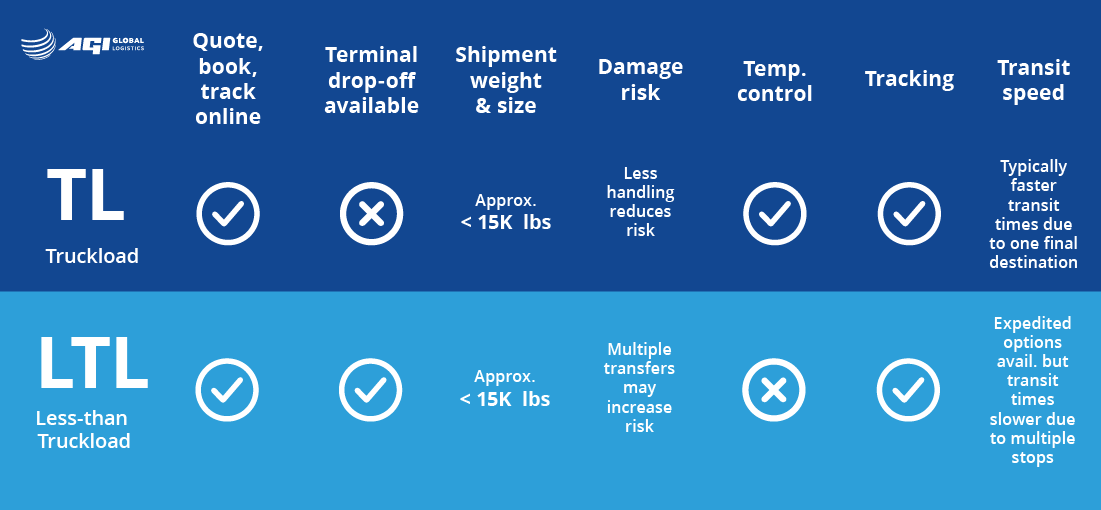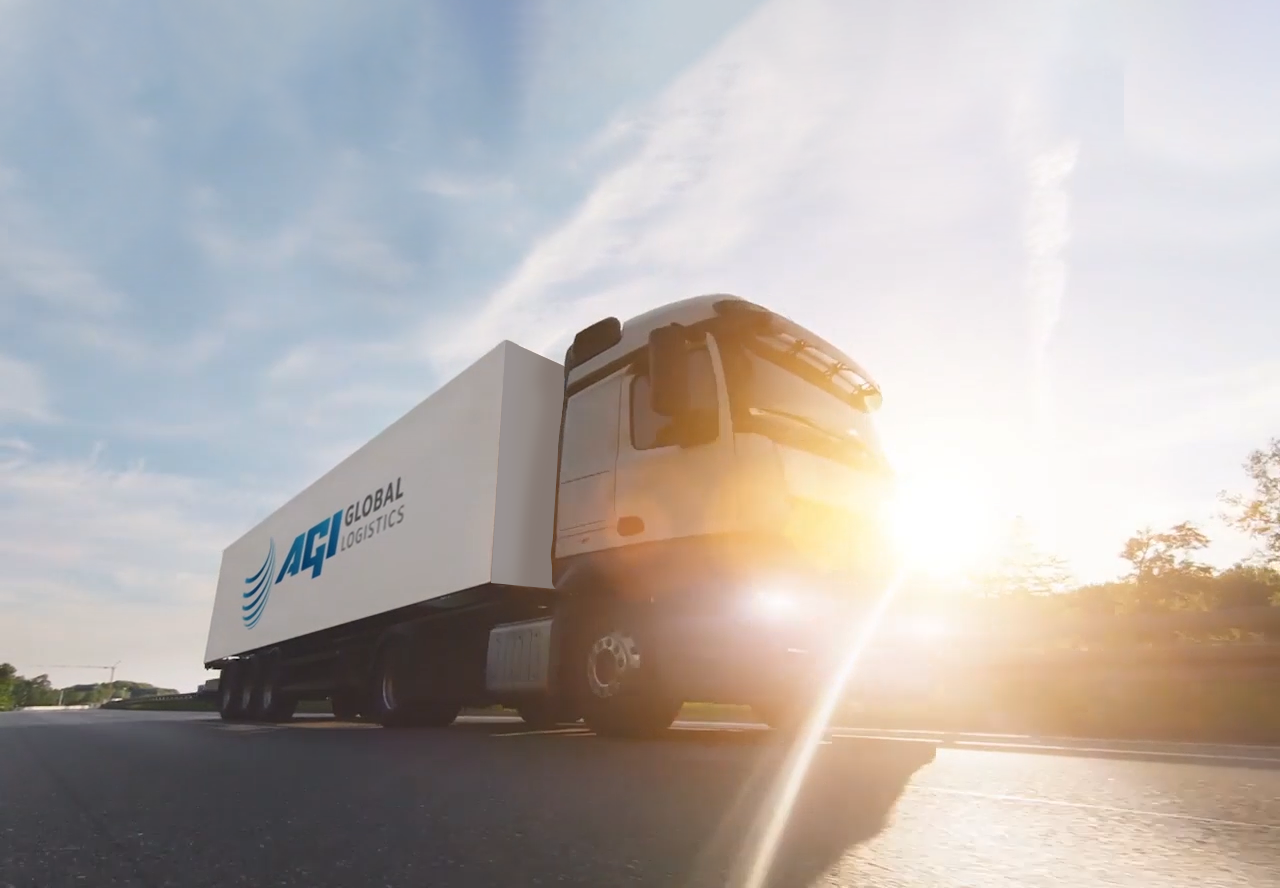Choosing the right shipping option is crucial for a timely and cost-effective delivery. Two common terms you may encounter when arranging shipments are ‘Less Than Truckload (LTL)’ and ‘Full Truckload (FTL)’.
Understanding the nuances between these two options is essential for businesses looking to streamline their road freight processes. In this article, we’ll delve into the specifics of LTL and FTL, highlighting the key differences to help you make informed decisions for your shipping needs.
What is Less Than Truckload (LTL)?
Less Than Truckload (LTL) is a shipping method designed for smaller shipments that don’t require the use of an entire truck. With LTL, multiple shipments from different customers are consolidated onto a single truck, which is particularly cost-effective for businesses that have smaller quantities of goods to transport, as they only pay for the space their shipment occupies.
The key characteristics of LTL shipping include:
Partial Loads
LTL shipments typically do not fill an entire truck. Instead, the available space on a truck is divided among multiple shippers who have smaller loads.
Consolidation
LTL carriers consolidate shipments from different shippers at a hub or terminal. This allows for more efficient use of transportation resources and helps reduce costs for both carriers and shippers.
Freight Class
LTL shipments are classified based on their weight, dimensions, density, and other factors. Each shipment is assigned a freight class, which helps determine the shipping rates.
Hub and Spoke System
LTL carriers often operate on a hub-and-spoke system, where regional hubs serve as consolidation points. Smaller shipments are collected from various locations, brought to the hub, and then redistributed to their final destinations.
Cost Savings
LTL shipping can be more cost-effective for shippers with smaller loads that do not require an entire truck. By sharing space with other shippers, the cost of transportation is distributed among multiple parties.
Tracking and Tracing
LTL carriers usually provide tracking and tracing services, allowing shippers to monitor the progress of their shipments in real-time.
LTL shipping is commonly used by businesses that have smaller quantities of goods to transport and do not require the use of a full truck. It offers a more economical and sustainable option for shipping smaller loads, as it maximises the use of available truck space and reduces the environmental impact associated with underutilised transportation capacity.
What is Full Truckload (FTL)?
Full Truckload (FTL), on the other hand, is when the entire cargo space of the truck is dedicated to a single shipment or the combined shipments of a single shipper. This is in contrast to Less Than Truckload (LTL) shipping, where multiple smaller shipments from different shippers share space on a single truck.
Exclusive Use
In FTL shipping, the shipper pays for the entire truck, and the truck is exclusively used to transport their goods. This is beneficial for shippers with large quantities of freight that require the entire capacity of a truck.
Direct Route
FTL shipments usually travel directly from the point of origin to the final destination without intermediate stops for consolidation. This can result in faster transit times compared to LTL shipments, which may have multiple stops for pick-ups and drop-offs.
Bulk Shipments
FTL is often preferred when a shipper has a large volume of goods to transport, and the shipment is large enough to fill the entire truck. This is common for businesses with significant production or distribution needs.
Fixed Pricing
Pricing in FTL shipping is often based on the distance travelled, rather than the weight or volume of the cargo. This can make it easier for shippers to calculate and predict shipping costs.
Less Handling
FTL shipments typically involve less handling compared to LTL shipments. Since the entire truck is dedicated to a single shipper, there is less risk of damage or loss during the transportation process.
Flexibility
Shippers have more control over the timing and scheduling of FTL shipments. They can choose when the truck is loaded, when it departs, and when it arrives at its destination.
FTL shipping is commonly used by businesses with large quantities of goods to transport, and when the cost of shipping is justifiable based on the volume of the shipment. It offers advantages in terms of speed, security, and direct service but may be less cost-effective for smaller shipments compared to the shared-space model of LTL shipping.
What is the Difference Between LTL and FTL Freight?
The primary difference between LTL and FTL freight lies in the size and volume of the shipments. LTL shipments are smaller, typically ranging from a few pallets to a fraction of the truck’s capacity. In contrast, FTL shipments utilise the entire truck, making them more suitable for larger shipments that require dedicated space.
Another crucial distinction is cost. LTL shipping is generally more cost-effective for smaller shipments, as businesses share the expenses of the truck with other shippers. FTL shipments, while faster and more direct, can be more expensive due to the exclusive use of the entire truck.

When to Use Less Than Truckload (LTL)
LTL is the preferred option when cost efficiency is a top priority. If your shipment doesn’t require the entire truck, LTL allows you to pay for the space you use, helping you save on shipping expenses. When dealing with smaller quantities of goods that do not fill an entire truck, LTL is also the logical choice. This option is tailored for businesses that don’t have enough products to justify the cost of a full truck.
LTL shipments often have more flexible delivery timelines since the truck may make multiple stops along the route. If your shipment isn’t time-sensitive, LTL can be a cost-effective and practical solution.
When to Use Full Truckload (FTL)
If your goods require expedited delivery and cannot afford delays from multiple stops, FTL is the better option. With FTL, your shipment goes directly to its destination without intermediate stops too. And when dealing with a substantial volume of goods that fill or nearly fill a truck, FTL would also be the most efficient choice. This ensures that your products have exclusive use of the truck, minimising the risk of damage or loss during transit.
FTL shipments involve less handling, reducing the risk of damage compared to LTL shipments, which may be loaded and unloaded multiple times throughout the journey.
Full Truckload vs Less Than Truckload
LTL is generally more cost-effective for smaller shipments, allowing businesses to share the costs of transportation. FTL, while pricier, offers faster delivery and exclusive use of the truck. LTL shipments may also take longer due to multiple stops along the route. FTL shipments are more direct, resulting in faster transit times.
The size of your shipment is a critical factor. LTL is suitable for smaller shipments, while FTL is designed for larger quantities that justify the use of an entire truck.
Choosing between LTL and FTL depends on various factors, including shipment size, budget constraints, and delivery timelines. Understanding the nuances of each option is crucial for making informed decisions that align with your business needs. Whether you opt for the cost efficiency of LTL or the speed and exclusivity of FTL, partnering with a reliable freight forwarder can streamline your shipping processes and ensure your goods reach their destination seamlessly.
Are you ready to optimise your shipping strategy? If so, contact us for expert freight forwarding and logistics solutions. Our team is here to guide you in choosing the most efficient shipping option for your business needs. And for all of the latest AGI news, don’t forget to follow us on LinkedIn and Facebook!
